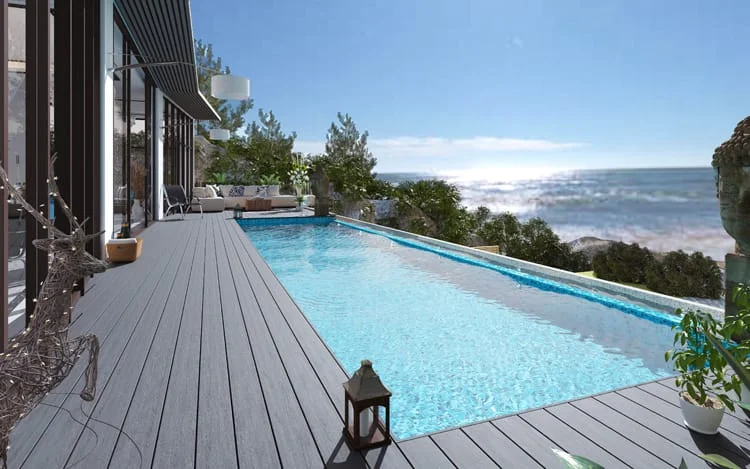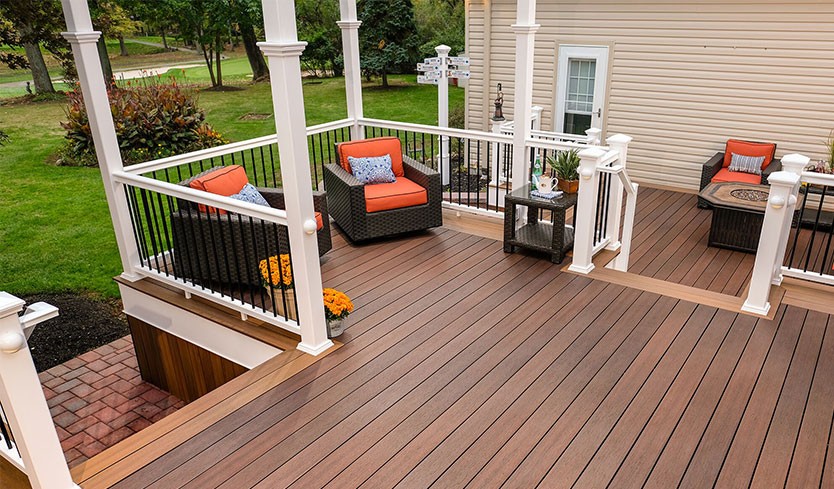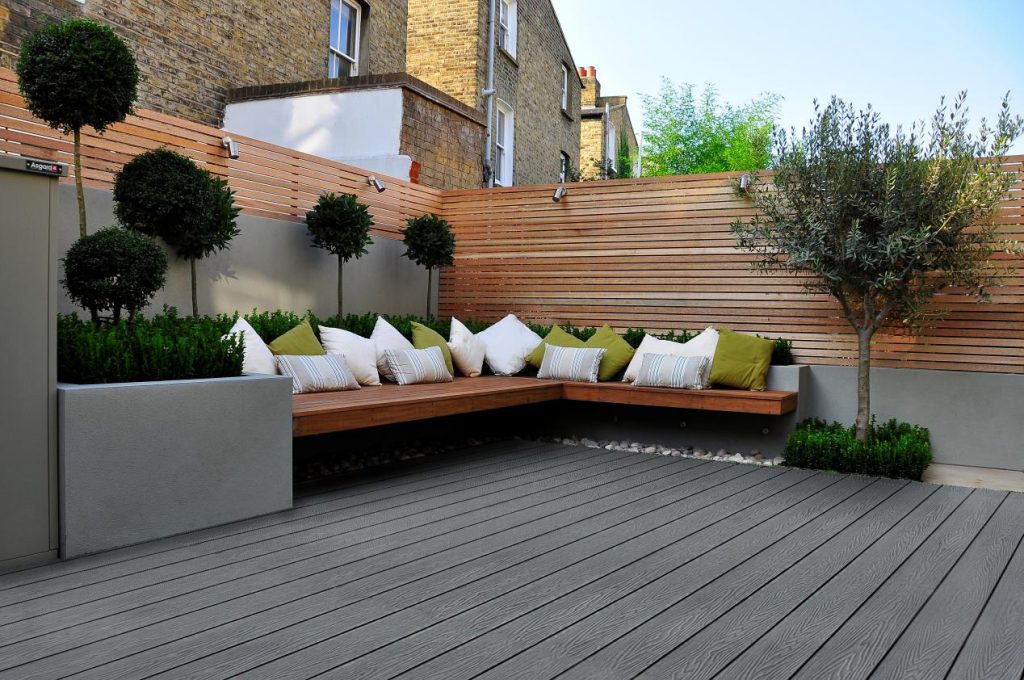When you want to designing a luxurious and functional poolside area, choosing the best composite decking for pool area is crucial. This is not just about aesthetics—it’s about safety, durability, slip-resistance, weather resilience, and comfort. With increasing awareness of long-term maintenance and sustainability, more homeowners, resorts, and architects are turning toward composite decking over traditional wood or concrete options for pool environments.
Table of Contents
Why Choose Composite Decking Around Your Pool?
1.1 Durability in Wet Conditions
Pool decks are constantly exposed to water, UV rays, and fluctuating temperatures. Traditional wood may warp, crack, or rot over time in such conditions. Composite decking, made from a blend of wood fibers and plastic polymers, is resistant to these issues. This makes it ideal for pool environments where longevity matters.
1.2 Slip-Resistance for Safety
Safety around the pool is paramount. Most high-quality composite decking comes with slip-resistant textures or finishes. This reduces the risk of accidents even when the surface is wet, especially important for children and elderly users.
1.3 Low Maintenance
Unlike wood, composite decking doesn’t require regular sealing, staining, or sanding. A simple wash with mild soap and water is typically enough to keep it looking new. This low-maintenance aspect is one of the biggest advantages for busy homeowners.
1.4 Aesthetic Versatility
Composite decking is available in a wide range of colors, wood grain patterns, and finishes that mimic natural wood but without the maintenance hassles. Whether you’re going for a tropical resort vibe or a minimalist modern look, there’s a composite decking style that suits your pool area.
1.5 Environmentally Friendly
Many composite decking boards are made from recycled materials. If sustainability is important to you, this is an added bonus. Choosing composite can help reduce deforestation and landfill waste.
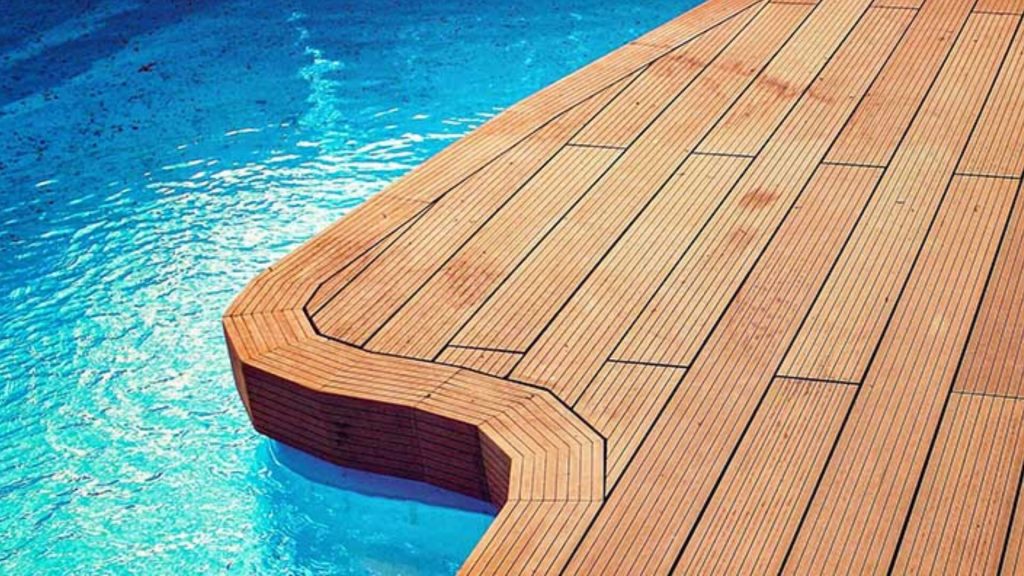
Features That Define the Best Composite Decking for Pool Area
Not all composite decking is created equal, especially when it comes to moisture-heavy environments like pools. Here are the must-have features:
2.1 Water Resistance
Ensure the boards are fully capped—this means they are sealed on all sides with a moisture-resistant polymer shell. Capped composite boards prevent water absorption, which in turn stops swelling, mold, and mildew growth.
2.2 UV Resistance
Constant exposure to the sun can fade most materials. Choose decking with UV inhibitors in the surface layer to resist color fading and surface breakdown over time.
2.3 Slip Resistance Rating
Decking should have a certified slip-resistance rating suitable for wet environments. Look for R11 or higher for wet barefoot areas.
2.4 Heat Resistance
Some composite decks absorb and retain heat, which can make them too hot to walk on during summer. Opt for lighter colors or thermally modified boards that stay cooler underfoot.
2.5 Texture and Surface Finish
Textured or embossed finishes improve grip and safety. Grooved boards also assist in water drainage and reduce pooling.
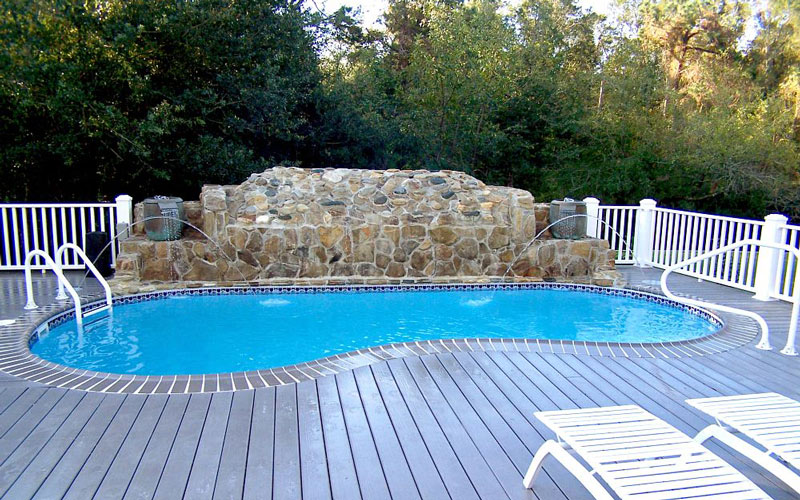
Types of Best Composite Decking for Pool Areas
Choosing the best composite decking for pool area involves understanding the various material technologies available today. Composite decking has evolved over the years into three primary categories, each offering distinct advantages and trade-offs depending on your budget, design preference, and environmental conditions.
3.1 Capped Composite Decking
Capped composite decking is widely considered the most advanced and pool-friendly option in the composite category. These boards consist of a recycled wood fiber and plastic core, enclosed in a polymer cap layer on all sides or at least three sides. This cap acts as a moisture barrier and protects the board from external elements like UV rays, water, chlorine, sunscreen, and algae.
Key Features:
Moisture resistance: The cap layer prevents water from penetrating the board, significantly reducing risks of swelling, warping, or mold buildup.
UV stability: Premium capped composites contain UV inhibitors that prevent fading even after years of sun exposure.
Stain resistance: The polymer shell also protects against oils, food spills, and pool chemicals.
Variety of finishes: Available in multiple colors, wood grain textures, and matte or embossed finishes.
Recommended For:
Homeowners seeking a long-term, worry-free solution
Pool decks with frequent exposure to water and direct sunlight
Areas where design and luxury appearance matter
Pros:
Excellent water and fade resistance
Easy to clean with just soap and water
Resists mold, mildew, and pool chemicals
Long warranties (typically 25 to 50 years)
Realistic wood-look finishes available
Cons:
Slightly more expensive than uncapped versions
Can get warm under direct sunlight (choose lighter colors for heat mitigation)
3.2 PVC Decking (Full Synthetic Decking)
Although technically not a composite (as it doesn’t contain wood fibers), PVC decking is a 100% synthetic alternative often recommended for pool decks due to its complete imperviousness to water. These boards are made from polyvinyl chloride and are extremely resistant to moisture, stains, insects, and fading.
Key Features:
Full waterproofing: Because there’s no organic material, PVC is inherently resistant to rot, warping, or mold.
Lightweight: Easier to handle and install compared to composite boards.
Cooler underfoot: Many PVC options are engineered with reflective technologies to remain cooler in hot climates.
Scratch and dent resistance: Tough outer shell provides strong impact resistance.
Recommended For:
Tropical or coastal regions with high humidity
Pool decks requiring absolute water-resistance
Lightweight deck structures where weight is a concern
Pros:
100% waterproof, even in submerged conditions
Requires no sealing, staining, or painting
Resists fading, cracking, and warping
Often cooler than capped composites in hot sun
Cons:
More expensive than other options
May lack the natural texture or color variation of wood-based composite
Some products may have a more plastic-like appearance
3.3 Uncapped Composite Decking (Budget Option)
Uncapped composite decking is the earlier generation of composite products. These boards feature a wood–plastic core but lack the protective outer cap found in modern alternatives. While they still resist rot better than real wood, they are much more prone to staining, water absorption, and surface fading.
Key Features:
Affordable upfront cost: Ideal for projects with limited budgets.
Wood-plastic blend: Often contains more wood fiber, which increases vulnerability to moisture over time.
Limited finish options: Typically available in fewer colors and less refined textures.
Recommended For:
Covered or semi-covered pool decks (less exposure to water and sun)
Temporary or rental property upgrades
DIY projects with cost constraints
Pros:
Lower initial cost
Better than wood in terms of resistance to insects and splintering
Easier to cut and work with for DIY installation
Cons:
No cap layer means more susceptible to moisture, fading, and mold
Shorter lifespan and warranties (usually under 10 years)
Requires more frequent cleaning and care
✅ Comparison Table: Best Composite Decking Options for Pool Areas
| Feature / Type | Capped Composite Decking | PVC Decking (Full Synthetic) | Uncapped Composite Decking |
|---|---|---|---|
| Water Resistance | ★★★★☆ (High) | ★★★★★ (Very High) | ★★☆☆☆ (Moderate) |
| Slip Resistance | ★★★★☆ (Textured Options) | ★★★★☆ (Varies by brand) | ★★☆☆☆ (Not ideal when wet) |
| UV & Fade Resistance | ★★★★☆ | ★★★★★ | ★★☆☆☆ |
| Mold/Mildew Resistance | ★★★★☆ | ★★★★★ | ★☆☆☆☆ |
| Maintenance Level | Low | Very Low | Medium |
| Aesthetics (Wood-look Realism) | ★★★★★ | ★★★★☆ (Sleek but synthetic look) | ★★☆☆☆ |
| Heat Retention | Medium (lighter colors better) | Low to Medium (cooler underfoot) | High |
| Cost | $$$ | $$$$ | $ |
| Typical Warranty | 25–50 years | 30–50 years | 5–10 years |
| Recommended for Pool Decks? | ✅✅✅ Best Choice | ✅✅✅ Excellent | ⚠️ Only if covered & dry area |
Key Considerations for Choosing the Best Composite Decking for Pool Area
4.1 Local Climate
In hot regions, heat-reflective boards in lighter shades are preferable. In humid zones, focus on mold resistance and capped technology. Cold climates require boards with high freeze-thaw durability.
4.2 Color and Design
Neutral colors like grey, sand, or taupe complement modern pools, while deep brown or reddish tones offer a more tropical or traditional look. Consider mixing board colors or using picture framing for visual interest.
4.3 Board Size and Profile
Wider boards create a more luxurious feel, while narrower ones are better for smaller decks. Choose hidden fastener-compatible profiles for a sleek, barefoot-friendly surface.
4.4 Budget
Prices range widely from $2 to $10+ per linear foot. Capped composite and PVC decking fall on the higher end but offer the best ROI around pools. Always factor in long-term maintenance savings when considering upfront cost.
4.5 Warranties and Certifications
Top manufacturers offer warranties of 25–50 years against fading, staining, and structural defects. Check for third-party certifications like ASTM slip resistance or FSC recycled content for added assurance.

Design Tips for Composite Pool Decking
Creating a visually stunning pool deck takes more than just picking the right boards. Here are some design insights:
5.1 Integrated Drainage
Ensure your deck includes proper spacing between boards and integrates slope or hidden drainage systems to manage runoff and prevent water accumulation.
5.2 Border Framing
Use contrasting colors for deck borders or steps to add visual depth and assist with safety by highlighting level changes.
5.3 Curved Decking
Some composite decking lines allow for curved installations—ideal for rounded pools and organic landscape designs.
5.4 Lighting Integration
Add LED strips under steps or railings for enhanced nighttime safety and ambiance.
5.5 Furniture and Decor Compatibility
Composite decking can support heavy furniture and resists stains from spilled food, drink, or sunscreen—making it practical for poolside dining or lounging setups.
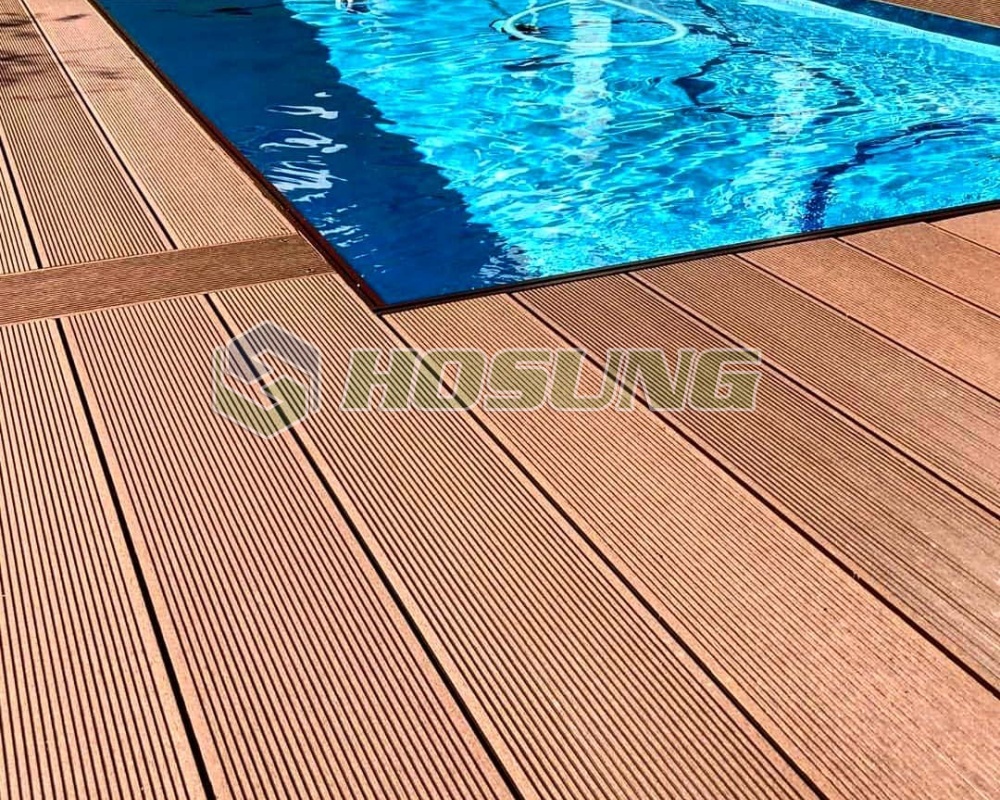
Installation Tips for Composite Pool Decks
6.1 Hire a Professional
While DIY installation is possible, pool environments are complex due to moisture, terrain, and drainage. An experienced installer ensures proper framing, board spacing, and waterproofing.
6.2 Use the Right Fasteners
Stainless steel or hidden fasteners work best. Avoid galvanized nails which can corrode over time, especially in wet settings.
6.3 Mind the Expansion Gaps
Composite expands and contracts with temperature changes. Leave the correct spacing as per manufacturer’s guidelines to avoid buckling.
6.4 Consider Under-Deck Drainage Systems
If your deck is elevated, using an under-deck drainage system can create a dry area below for storage or additional seating.
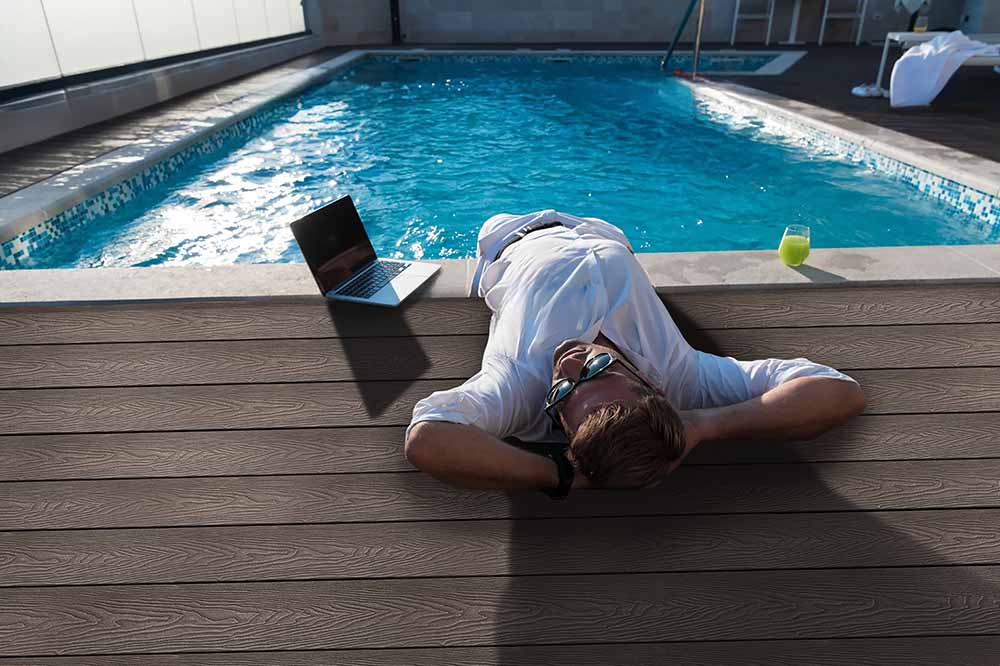
Best Composite Decking for Pool Area: Final Thoughts
Choosing the best composite decking for pool area comes down to understanding your needs: durability, safety, aesthetics, and maintenance. Capped composite decking, particularly those designed with slip resistance and UV protection, are clear winners for most residential and commercial pool projects.
To Summarize: What Makes It the Best?
Capped composite or PVC material
R11+ slip resistance rating
UV and heat resistance
Stylish, fade-resistant finishes
Long warranty and low maintenance
Whether you’re designing a backyard pool deck, a hotel lounging area, or a luxury spa patio, composite decking offers the ideal blend of beauty and functionality.
Looking for the Best Composite Decking Supplier?
If you’re ready to transform your pool area with premium composite decking, it’s essential to source materials from a reliable and experienced manufacturer. Get in touch with a trusted supplier that offers moisture-resistant, slip-proof, and UV-stable composite decking tailored for swimming pool environments.
Contact Hosung WPC today to explore a variety of composite decking styles perfect for poolside use. Their products are crafted for durability, beauty, and peace of mind.

